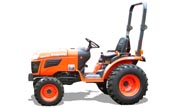
Kubota B2620 Compact Utility tractor Technical Specifications
Kubota B2620 is a Row-Crop tractor that was produced by the John Deere between 2008 – 2015.
Below you will find detailed technical specifications for Kubota B2620 covering engine types, horsepower ratings, weight, height, fuel type and tank volume, oil capacity and type, hydraulic system diagram, wiring diagram, battery specs, etc.
Kubota B2620 Production
| Manufacturer: | |
| Manufacturer: | Kubota |
| Type: | Compact Utility tractor |
| Original price: | $13,888 (2011) |
| Engine: | |
| Engine (gross): | 26 hp 19.4 kW |
| PTO (claimed): | 19 hp 14.2 kW |
| Kubota B2620 Engine | |
| Kubota 1.1L 3-cyl diesel |
| Mechanical | |
| Chassis: | 4×4 MFWD 4WD |
| Differential lock: | rear standard |
| Steering: | hydrostatic power |
| Brakes: | wet disc |
| Cab: | Two-post foldable ROPS. Sunshade optional. |
| Transmission: | hydrostatic |
| Kubota B2620 photos… |
| Capacity | |
| Fuel: | 6.6 gal 25.0 L |
| Hydraulic system: | 4 gal 15.1 L |
| Hydraulics | |
| Type: | open center |
| Capacity: | 4 gal 15.1 L |
| Valves: | 1 or 2 |
| Pump flow: | 4.7 gpm 17.8 lpm |
| Total flow: | 8.3 gpm 31.4 lpm |
| Steering flow: | 3.6 gpm 13.6 lpm |
| Tractor hitch | |
| Rear Type: | 1 |
| Rear lift (at ends): | 1,356 lbs 615 kg |
| Rear lift (at 24″/610mm): | 1,058 lbs 479 kg |
| Power Take-off (PTO) | |
| Rear PTO: | live |
| Rear RPM: | 540/960 (1.375) |
| Engine RPM: | 540@2773 960@2722 |
| Mid PTO: | optional |
| Mid RPM: | 2500 |
| Engine RPM: | 2500@2750 |
| Dimensions & Tires | |
| Wheelbase: | 61.5 inches 156 cm |
| Weight: | 1,554 lbs 704 kg |
| Front tire: | 7-12 |
| Rear tire: | 11.2-16 |
| B2620 Serial Numbers | |
| Location: | Serial number plate on the right side of the B2620 frame, above the front axle. |
Kubota B2620 Electrical
| Ground: | negative |
| Charging system: | alternator |
| Charging amps: | 14.5 |
| 40 (optional) | |
| Battery volts: | 12 |
Kubota B2620 Mechanical
| Chassis: | 4×4 MFWD 4WD | ||||||||||||||||||||||||||||||||||||||||||||||||||||||||||||||||||||||||||||||||||
| Differential lock: | rear standard | ||||||||||||||||||||||||||||||||||||||||||||||||||||||||||||||||||||||||||||||||||
| Steering: | hydrostatic power | ||||||||||||||||||||||||||||||||||||||||||||||||||||||||||||||||||||||||||||||||||
| Brakes: | wet disc | ||||||||||||||||||||||||||||||||||||||||||||||||||||||||||||||||||||||||||||||||||
| Cab: | Two-post foldable ROPS. Sunshade optional. | ||||||||||||||||||||||||||||||||||||||||||||||||||||||||||||||||||||||||||||||||||
| Transmission: | hydrostatic | ||||||||||||||||||||||||||||||||||||||||||||||||||||||||||||||||||||||||||||||||||
Capacity
Hydraulics
Tracktor Hitch
Power Take-off (PTO)
Kubota B2620 Engine detail
Kubota B2620 Dimensions
FAQIs Kubota B2620 a good tractor? The Kubota B2620 is one of the great tractors in the Kubota stable, and it has earned Kubota a fantastic reputation. How much oil does a Kubota B2620 take? Check out the Kubota B2620 oil capacity and oil type in the engine specs section as it may vary across the engines. Keep in mind, that older models might have their oil capacity increased over time. You may compare between the early and late oil capacity. Do tractors have VIN numbers? Every tractor has a VIN number. The number is usually engraved below the driver’s seat. Tractor manufacturers put the number in different places on the tractor body. What was the last year Kubota made the B2320 The Kubota B2620 was an agricultural tractor model made from 2008 – 2015 | |||||||||||||||||||||||||||||||||||||||||||||||||||||||||||||||||||||||||||||||||||
